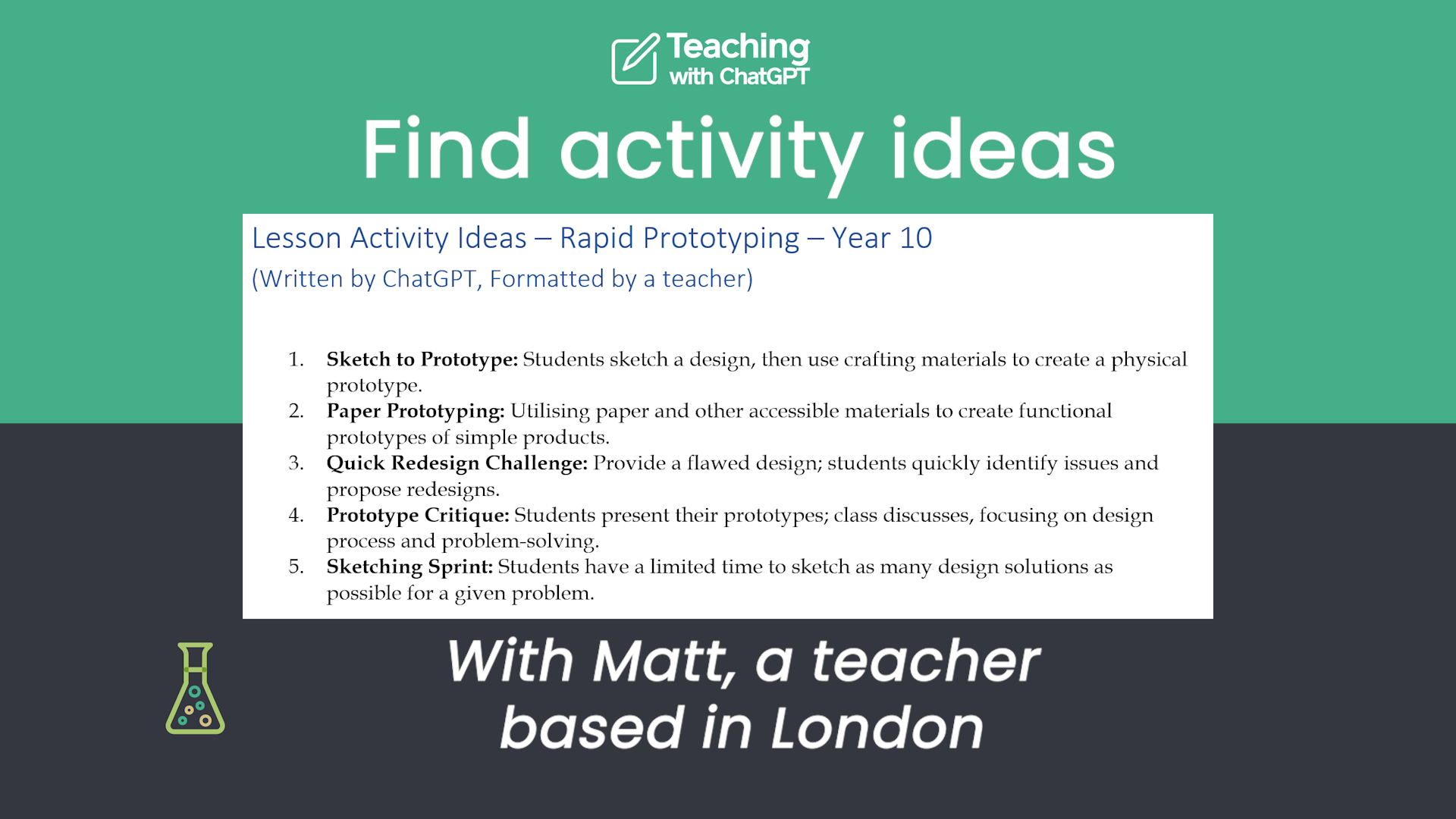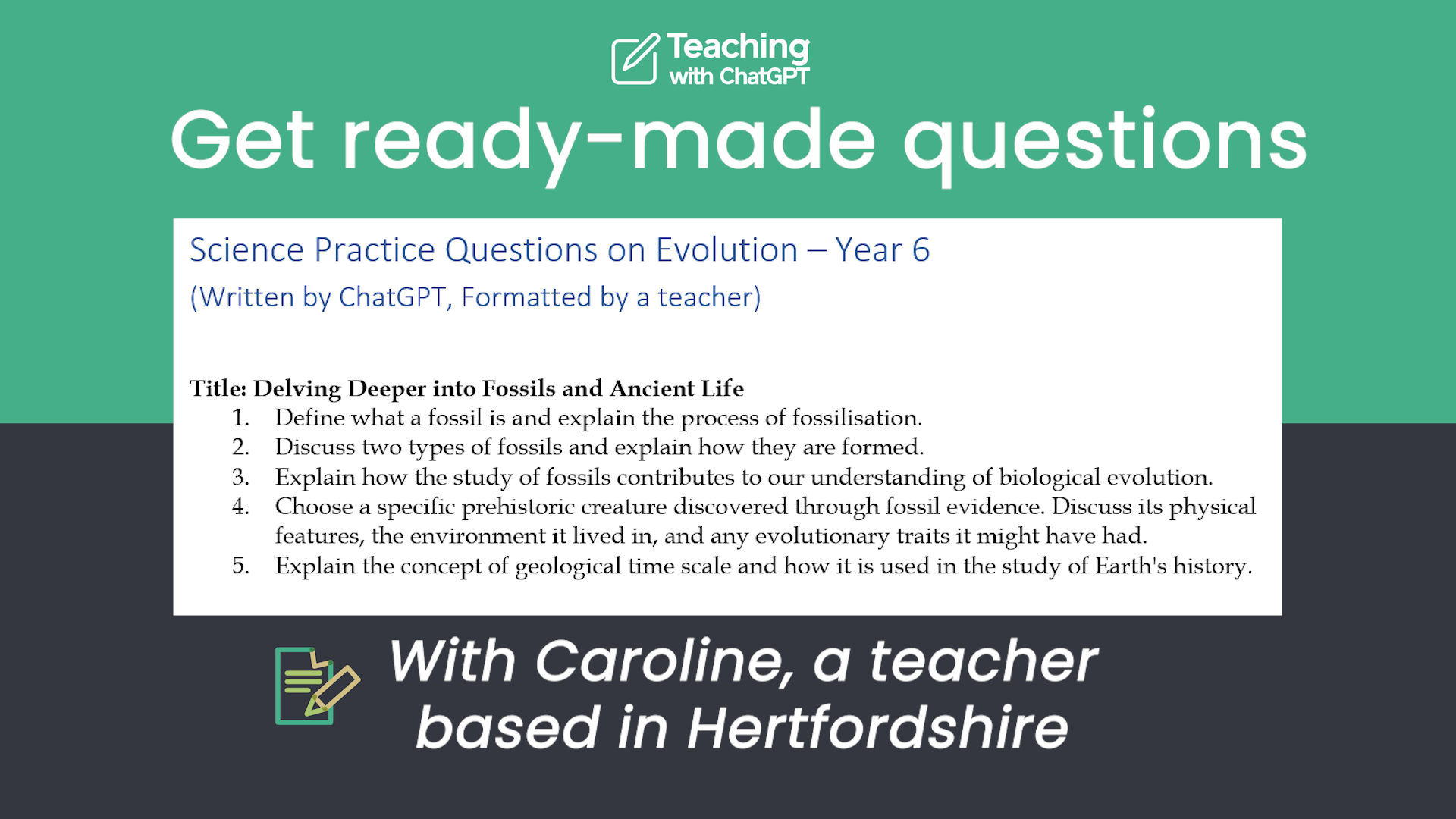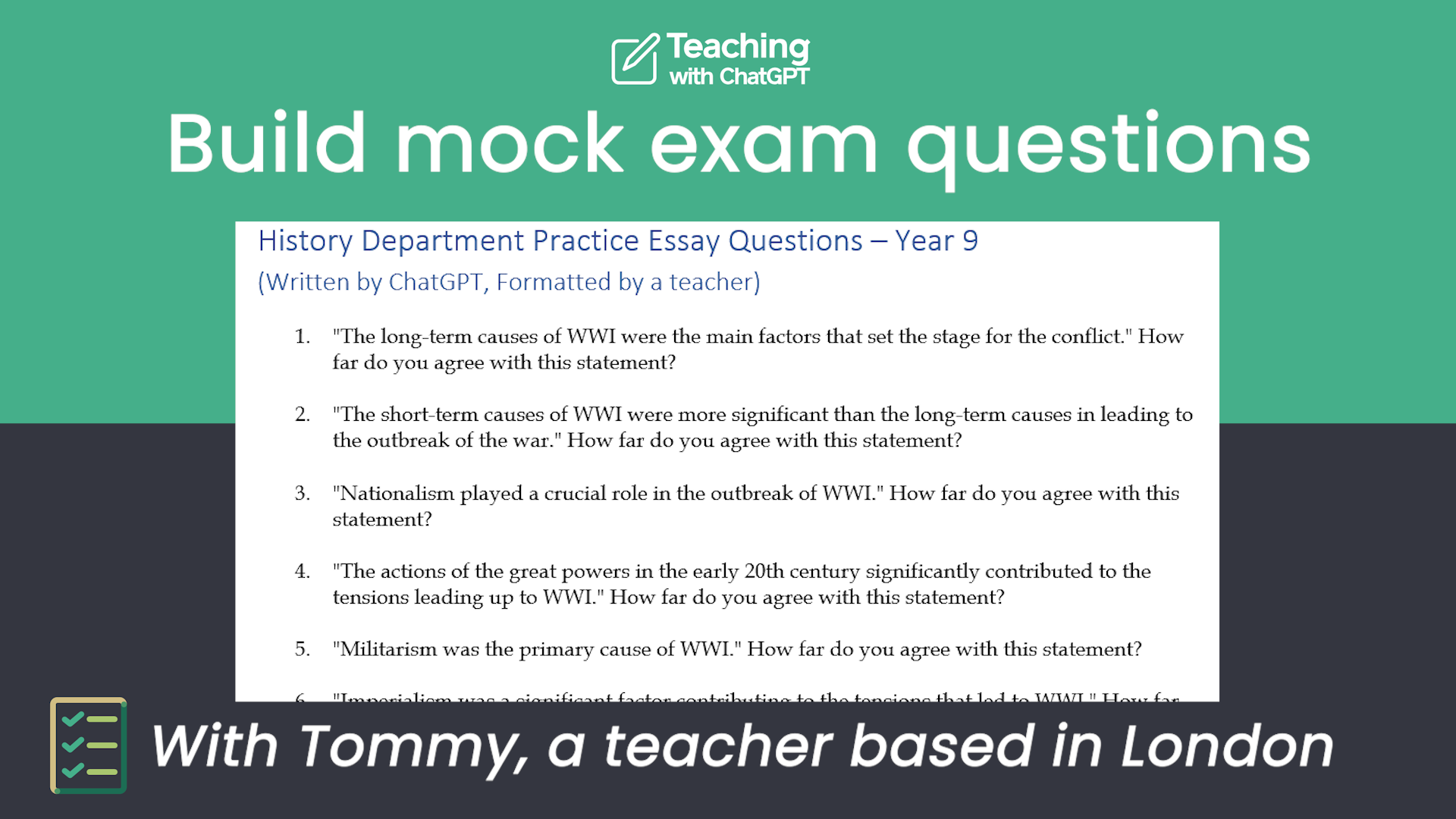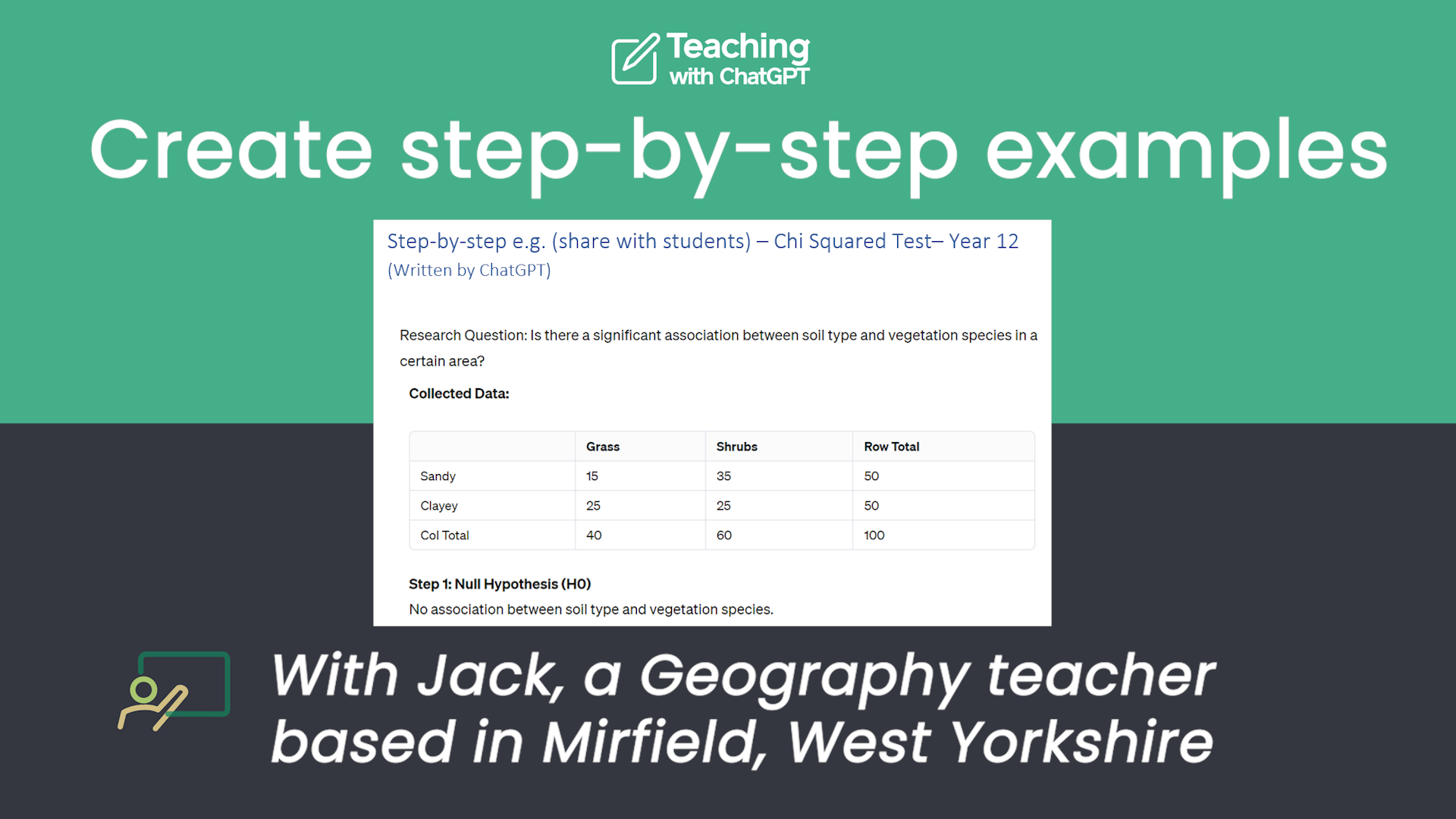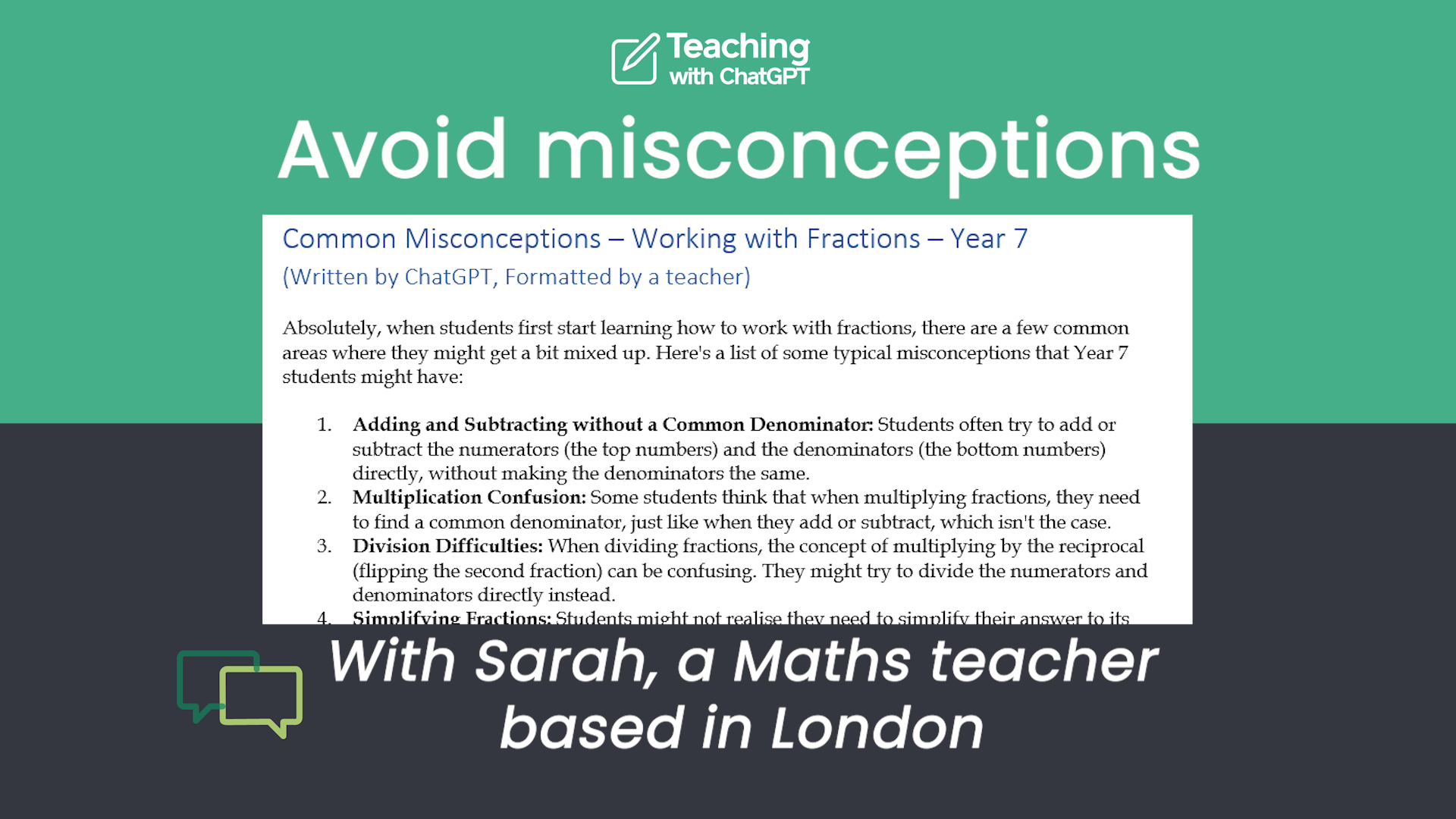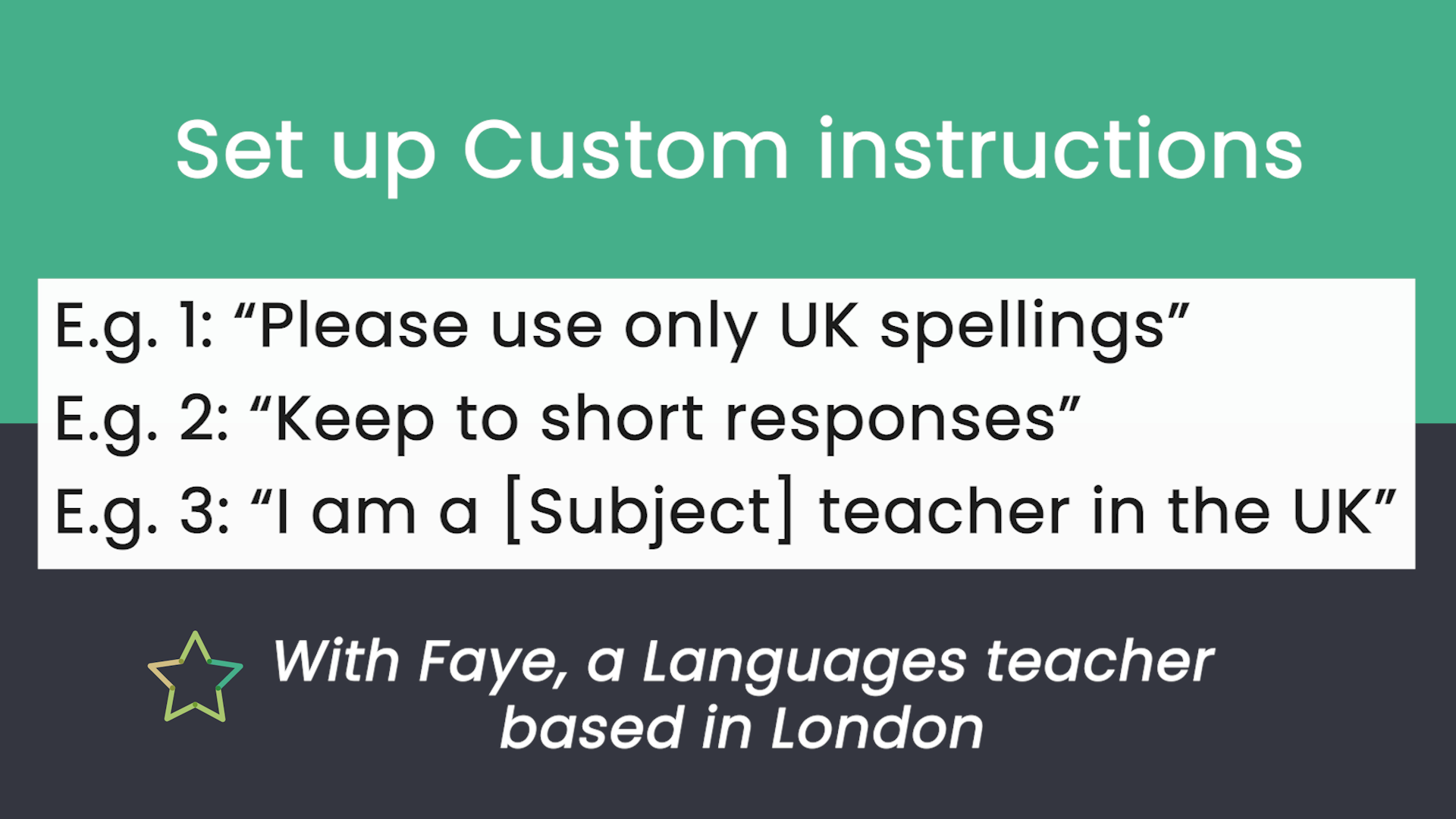
Using ChatGPT in the classroom.
Get ChatGPT working for you.
6 things you can do today with ChatGPT, with tips & tricks from teachers and tutors:
Important: ChatGPT can make mistakes - check materials carefully before using in class, including sense checking with school resources or with a colleague if you need to.
Note that ChatGPT defaults to US spellings unless you ask for UK spellings.
Find activity ideas in seconds.
-
Ask for a long list of ideas
Y6 English example: “Give me 10 ideas for activities for my Year 6 English class on similes, using Goodnight Mister Tom?”
Review the list, tweak your request & repeat
Y6 English example follow-up: “Please provide an updated list of 10 activities that are full-class activities vs. individual work.”
Narrow down your long list
Either pick the activities yourself or ask ChatGPT to narrow the list down, E.g. “Of the ideas you’ve generated, which 3 would work best for a mixed ability group?”
-
Follow along with the chat shown in the video:
Year 10 Engineering (Rapid Prototyping)More examples:
Y8 PSHE (Peer Pressure)
Y8 Biology (Photosynthesis)
Y7 Spanish (Holiday vocabulary)
Get ready-made practice questions.
-
Be specific about the number, style and content of the questions you need
E.g. “Write me 20 questions about the use of imagery in Of Mice and Men, appropriate for my Year 9 class. They should require short, full-sentence answers.”
Check the level and wording of the questions you receive, then give feedback and adjust as required
E.g. “Can you generate some more questions which are more varied in style? They shouldn’t all begin with ‘describe’.”
E.g. “Can you add 5 stretch questions for high attainers and 5 support questions to scaffold learning for lower attainers?”
-
Follow along with the chat shown in the video:
Y6 Science (Evolution)More examples:
Y8 Maths (Simultaneous Equations)
Y9 English (Imagery)
GCSE Physics (Flashcards)
“The kids have begun to pick up on how bespoke the materials I’m making with ChatGPT are. It's having a really positive impact.”
— Primary School Teacher
Adapt your materials to work for your group.
-
Paste in your materials and describe adjustments you need
Adjustments you could ask for:
Tier by attainment to stretch/ scaffold (E.g. “Add 5 stretch questions”)
Change the reading age (E.g. “Modify this text to suit a reading age of 10”)
Change the theme or style (E.g. “Rewrite these Maths questions to be themed around Star Wars”; “Rewrite this in a Gothic style”)
Adjust materials to suit pupils who have EAL (E.g. “Can you give me a glossary of KS3 periodic table vocabulary used in this worksheet, translated into Ukrainian, to help my Ukrainian-speaking student?”)
Adjust materials or activities to suit specific pupils’ needs (E.g. “Modify this activity to be better-suited to a student who struggles with group work”)
-
Follow along with the chat shown in the video:
Y9 English - (Tier, Reading Age, EAL)More examples:
Y9 Maths (Theme)
Y7 Chemistry (EAL)
Y7 English (Theme)
Y12 Economics (Scaffold/Stretch)
Craft model answers & build mock exams.
-
ChatGPT can create model answers, including at different grade profiles. To get the best results, provide an example mark scheme and/or previous examples of good answers
E.g. “I have pasted in an A Level French essay question and the course specification of skills to test when marking answers. Can you create an answer which would score highly on content and vocabulary but low on grammatical structures?”
-
For one type of question at a time:
Share detail using your own materials (E.g. your department’s scheme of work)
Ask for lists to build practice question banks
Compare suggestions to previous questions you have written
E.g. “I have pasted in a list of example essay questions for my Year 12 English class. I need 5 essay questions in this style about Cat On A Hot Tin Roof.”
-
Follow along with the chat shown in the video:
Y9 History (essay questions)More examples:
Model answers
GCSE History (Model & writing frame)
Y13 French (Speaking qs & answers)
Mock exam
GCSE English
“I’ve been using ChatGPT to adapt and improve my old resources, including adding scaffolding to my existing examples.”
— Maths tutor
Get effective explanations & create step-by-step examples.
-
ChatGPT can suggest effective explanations for your students
E.g. “Some of my students didn’t understand my first explanation of when the imperfect tense is used in French. Can you suggest 3 alternative ways I could explain it?”
-
Ask for a worked example, giving details about the year group, topic, exam board, etc.
E.g. “I am teaching trigonometry to Year 11 students. Can you provide a worked example, finding the length of a side of a triangle, using SOH CAH TOA, explaining each step in detail? Can you include a real-life example which will be relevant to this group, to help put it into context?”
Check the content and logic, adjusting the theme and detail if you need to
-
Follow along with the chat shown in the video:
Y12 Geography (Chi Squared Test)More examples:
Effective explanations
Y7 French (Imperfect tense)
Y9 Maths (Pythagoras)
Step-by-step examples
Y11 Maths (Trigonometry)
Test student understanding & avoid misconceptions.
-
ChatGPT can help you judge whether a lesson has been effective by giving you questions to test student understanding
E.g. “I am teaching Year 10 about osmosis. Given what they need to know about this topic at GCSE level, what questions can I ask to test their understanding?”
-
ChatGPT can anticipate & suggest ways to tackle common student misconceptions. This can be really helpful for topics you’re teaching for the first time
E.g. “I am teaching Year 7 students about Electricity. What are some misconceptions my students might have about these topics? How can I address them?”
-
Follow along with the chat shown in the video:
Y7 Maths (Working with Fractions)Other examples:
Test understanding
Y7 Chemistry (Atoms)
GCSE English (Shakespeare - lesson delivery & test understanding)
Avoid misconceptions
Y7 Physics (Electricity)
Other ways you could use ChatGPT in teaching…
-
Lesson plans: Teachers we worked with rated ChatGPT less highly for producing lesson plans vs. other areas.
Asking for a lesson plan as a standalone request, e.g. “Can you give me a 60 min lesson plan for my Y7 class on adding and subtracting fractions with unlike denominators?” will get you a lesson plan, but it will probably be less relevant, creative & detailed than what you were looking for.
We recommend teachers start by asking for the key elements of their lesson across multiple steps within one ChatGPT conversation, then ask ChatGPT to summarise it into a lesson plan.
Less useful plan: This plan for an English lesson, built from a single prompt without much context, isn’t necessarily a bad plan, but it’s unlikely to chime perfectly with what the teacher had in mind, because ChatGPT hasn’t been given enough context to deliver a genuinely relevant, useful plan. Link here
Useful, relevant plan: Here’s an example of a Maths lesson plan, with its key components built up step by step and summarised in a lesson plan at the end: Link here
ChatGPT as information source (latest curriculum, policies, exam specifications, teaching strategies etc.): While ChatGPT can come up with fact-based content, we would advise you to refer directly to your school’s curriculum & policies, exam board specifications & well-evidenced teaching strategies (e.g. EEF’s Teaching & Learning Toolkit) for this information, to ensure you are using the most accurate, up-to-date information.
Generative AI tools can “hallucinate”, presenting nonsensical or otherwise incorrect information as fact; it is therefore not a good idea to use generative AI tools as a single source for information.
Marking & Feedback: There’s a lot of excitement about the potential for generative AI tools to support teachers in marking student work & providing feedback, especially now you can use images (e.g. photos of handwritten text) as ChatGPT prompts.
While we think this could be an exciting area, from our testing (Autumn 2023), we struggled to get consistently high-quality results. In addition, there are potential risks around biases, safe-guarding and other policy issues which would need to be worked through before using generative AI tools to support teachers in this area.
For teachers interested in experimenting with ChatGPT for marking & feedback purposes, it is important to ensure you comply with your school’s data policy and with general best practice, e.g. “Have my pupils / has my school consented to me using their data / intellectual property in this way?” You can opt out of allowing OpenAI to use the data you input to train its model, but be aware that you will still be sending the data itself to OpenAI.
-
Admin: Generative AI has the potential to save time on school admin tasks, including letters to parents, school trip planning, report writing, etc.
Though not the focus of this site, many of the principles of using ChatGPT will apply here, too, e.g. provide context & examples of what you need; break requests into steps.
You shouldn’t share sensitive or personal data and, as ever, check your school’s policies on appropriate use of generative AI tools. Many schools do not allow the use of generative AI for report writing.In addition, concerns about potential bias in the datasets used to train generative AI models would need to be addressed for this use case to be applicable.

